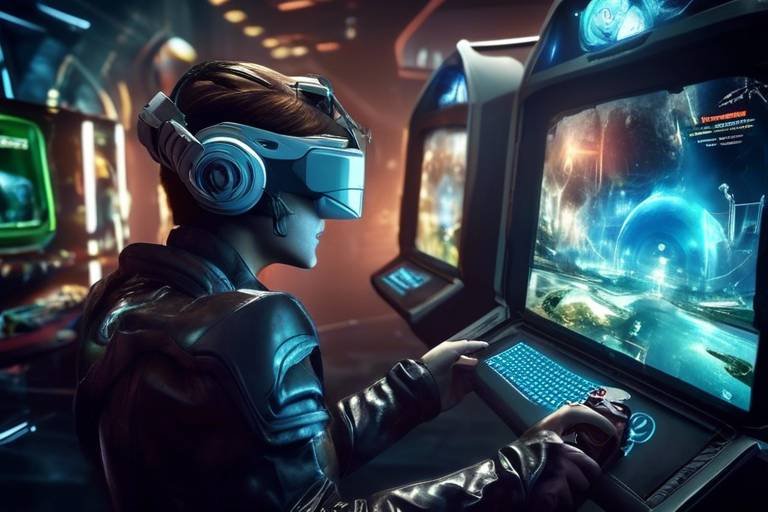Future Tech Trends in the Gaming Industry
The gaming industry is on the brink of a technological revolution, ushering in a new era of innovation that promises to reshape how we play, interact, and experience games. As we dive into the future of gaming, we see exciting trends that not only enhance gameplay but also redefine the entire gaming ecosystem. From immersive virtual reality to the integration of artificial intelligence, the possibilities are endless. This article explores these emerging technologies and their profound impact on the gaming landscape.
Virtual reality (VR) has come a long way since its inception, evolving into a powerful tool that offers players experiences that feel incredibly real. Imagine stepping into a game where the environment feels tangible, and your actions have genuine consequences. Recent advancements in VR technology have made this a reality. High-resolution displays and improved motion tracking create a seamless experience that immerses players in fantastical worlds.
Moreover, the development of VR accessories, such as haptic feedback gloves and full-body tracking suits, takes immersion to the next level. Players can now feel the weight of their weapons, sense the heat of explosions, and even interact with their surroundings in ways that were previously unimaginable. This evolution not only enhances gameplay but also transforms the way stories are told within games, allowing players to become active participants rather than mere spectators.
Augmented reality (AR) is another game-changer, bridging the gap between the digital and physical worlds. Unlike VR, which creates entirely new environments, AR overlays digital elements onto the real world. This technology has opened up new avenues for player interaction and engagement. Picture yourself walking through your neighborhood, only to discover hidden treasures and challenges waiting for you through your smartphone or AR glasses.
The rise of mobile devices has propelled AR gaming into the mainstream. Games like Pokémon GO have demonstrated how AR can encourage players to explore their surroundings while engaging with digital content. The success of these mobile AR games has inspired developers to create more innovative experiences that blend the virtual with the real, making gaming a social and interactive endeavor.
Location-based AR games provide unique experiences by merging digital content with real-world locations. These games encourage players to venture outside, explore new places, and connect with others. Imagine joining a scavenger hunt that leads you to historical landmarks or local parks, where you can unlock achievements and rewards. This not only promotes physical activity but also fosters a sense of community among players.
Competitive gaming is increasingly incorporating AR elements, enhancing strategy and player engagement in esports. Imagine a scenario where players use AR overlays to visualize their opponents' movements or strategize in real-time. This integration of AR can elevate the competitive edge, making matches more thrilling and unpredictable.
Cloud gaming is changing how players access and enjoy games. With the ability to stream games directly to devices without the need for expensive hardware, cloud gaming services like Google Stadia and NVIDIA GeForce NOW are democratizing the gaming experience. Players can enjoy high-quality graphics and gameplay on various devices, from smartphones to smart TVs.
However, while the benefits are clear, challenges remain. Issues such as latency and internet connectivity can impact the gaming experience. As technology improves, we can expect these challenges to diminish, making cloud gaming a staple in the industry.
Artificial intelligence (AI) is revolutionizing game development by enabling smarter non-player characters (NPCs) and personalized experiences. Imagine playing a game where the NPCs adapt to your playstyle, offering unique challenges and interactions. AI allows developers to create more dynamic and engaging worlds, where every player’s experience is tailored to their choices.
One of the most exciting applications of AI is procedural content generation. This technique uses algorithms to create expansive game worlds and assets, ensuring that no two playthroughs are the same. It allows developers to craft vast, dynamic environments without the need for extensive manual design, leading to a richer gaming experience.
AI-driven analytics are transforming how developers understand player behavior. By analyzing data on player actions and preferences, developers can refine game design and enhance user experience. This data-driven approach ensures that games not only meet player expectations but also keep them engaged for longer periods.
Blockchain technology is making waves in gaming, offering decentralized ownership and digital asset security. Players can truly own their in-game items, trade them freely, and even earn real money through gameplay. This shift empowers gamers and developers alike, creating a more transparent and fair gaming ecosystem.
As we look ahead, it's clear that the future of gaming is intertwined with these technological advancements. The landscape is evolving rapidly, promising exciting possibilities for players and developers. Are you ready to embrace the future of gaming?
- What is virtual reality in gaming?
Virtual reality immerses players in a completely digital environment, allowing them to interact with the game world in a realistic way.
- How does augmented reality enhance gaming?
Augmented reality overlays digital elements onto the real world, creating interactive experiences that encourage exploration and engagement.
- What are the benefits of cloud gaming?
Cloud gaming allows players to access games without the need for powerful hardware, making gaming more accessible.
- How is AI used in game development?
AI enhances game development by creating smarter NPCs, personalizing player experiences, and generating content dynamically.
- What role does blockchain play in gaming?
Blockchain technology provides secure ownership and trading of digital assets, empowering players and developers.

Virtual Reality Advancements
This article explores the emerging technologies shaping the gaming industry, highlighting innovations that enhance gameplay, improve user experience, and redefine how games are developed and consumed.
Virtual reality (VR) is not just a buzzword anymore; it's a revolution that's transforming the gaming landscape. Imagine stepping into a world where you can fight dragons, explore alien planets, or even solve mysteries in a haunted mansion—all from the comfort of your living room. This immersive experience is achieved through cutting-edge VR technologies that continue to advance at a breakneck pace.
One of the most exciting developments in VR is the enhanced realism that new hardware and software are bringing to the table. With advancements in graphics, sound, and haptic feedback, players are now able to experience games in ways that were once thought to be the stuff of science fiction. The latest VR headsets, such as the Meta Quest 3 and Valve Index, provide stunning visuals and an unparalleled field of view, making players feel as if they are truly inside the game. The haptic technology in controllers adds another layer of immersion, allowing players to feel the weight of their weapons or the impact of a virtual punch.
Moreover, VR is becoming more accessible. Early adopters of VR technology often faced high costs and complicated setups, but now, many affordable options are available. This accessibility is opening doors for a broader audience, which is crucial for the gaming industry. As more players enter the VR space, developers are encouraged to create a wider variety of games, from casual experiences to hardcore adventures.
Additionally, social interaction within VR is evolving. Multiplayer VR games are gaining popularity, allowing friends and strangers to connect in virtual spaces. Imagine playing a game of virtual poker with friends across the globe or teaming up to conquer a virtual fortress—all while feeling as if you're sitting in the same room. This social aspect is vital, as it not only enhances the gaming experience but also creates a sense of community among players.
But what does the future hold for VR? As technology continues to improve, we can expect even more lifelike experiences. Think about the potential for full-body tracking that would allow players to see their own movements replicated in the game world. This could lead to more interactive and engaging gameplay, where players can physically dodge attacks or perform complex maneuvers. Moreover, the integration of artificial intelligence could personalize experiences even further, adapting challenges and environments to suit individual player styles.
In summary, the advancements in virtual reality are not just about graphics and hardware; they are about creating a holistic experience that engages players on multiple levels. As the technology continues to evolve, we can expect VR to become an integral part of the gaming industry, offering experiences that are more immersive, social, and accessible than ever before.
- What is virtual reality (VR)?
Virtual reality is a simulated experience that can be similar to or completely different from the real world. It immerses users in a 3D environment where they can interact with the surroundings. - How does VR enhance gaming?
VR enhances gaming by providing immersive experiences that engage players physically and emotionally, allowing them to interact with the game world in ways that traditional gaming cannot. - Are VR games expensive?
While some VR games can be pricey, there are many affordable options available, especially as technology advances and becomes more widespread. - Can I play VR games with friends?
Yes! Many VR games offer multiplayer options, allowing you to team up or compete with friends in virtual environments.

Augmented Reality Integration
Augmented reality (AR) is not just a buzzword anymore; it’s rapidly becoming a game-changer in the gaming industry. Imagine stepping into your living room and seeing your favorite game characters come to life right in front of you! This technology is transforming how players interact with their environments, creating a seamless blend of the digital and physical worlds. With AR, the possibilities are endless, and it’s redefining engagement in ways we never thought possible.
One of the most exciting aspects of AR integration in gaming is how it enhances player engagement. No longer are players confined to their screens; they can now explore their surroundings while interacting with virtual elements. For instance, games like Pokémon GO have shown us how AR can encourage players to venture outside, discover new places, and socialize with others who share the same passion. This shift from traditional gaming to a more interactive experience is revolutionizing the way we play.
Let’s take a closer look at some of the ways AR is reshaping the gaming landscape:
- Interactive Gameplay: AR allows players to engage with the game in a more meaningful way. Instead of just pressing buttons, players can physically move around, manipulate objects, and even collaborate with others in real-time.
- Personalized Experiences: With AR technology, games can adapt to the player's environment. Imagine a puzzle game that changes based on the layout of your living room, or a treasure hunt that leads you to local landmarks!
- Enhanced Storytelling: AR can bring narratives to life by overlaying digital characters and stories onto the real world, allowing players to feel like they are part of the action.
As AR continues to evolve, we are witnessing a surge in mobile AR games, which have made this technology more accessible than ever. With the rise of smartphones equipped with powerful cameras and sensors, players can enjoy AR experiences anywhere, anytime. This accessibility has opened the floodgates for developers to create innovative games that leverage the potential of AR.
The popularity of mobile AR games has skyrocketed in recent years. Titles like Harry Potter: Wizards Unite and Ingress have captivated audiences by blending the excitement of gaming with real-world exploration. These games not only provide entertainment but also foster a sense of community among players who share similar interests. The social aspect of mobile AR games encourages players to connect, collaborate, and compete, making the experience even more engaging.
Location-based AR games are particularly fascinating. They merge digital content with real-world locations, creating unique experiences that encourage players to explore their surroundings. For example, games like Pokémon GO utilize GPS technology to place virtual creatures in real-world locations. Players must physically travel to these spots to catch them, turning everyday walks into thrilling adventures. This not only promotes physical activity but also encourages social interaction as players gather at popular locations to play together.
Competitive gaming is also embracing AR elements, enhancing strategy and player engagement in esports. Imagine a scenario where players can visualize their opponents' movements in real-time, or see overlays of game stats and analytics right in front of them. This integration can lead to a more immersive and strategic gaming experience, allowing players to make informed decisions on the fly. As AR technology continues to advance, we can expect to see even more innovative applications in the competitive gaming arena.
In conclusion, augmented reality is not just a passing trend; it’s a revolutionary force in the gaming industry. By enhancing engagement, fostering social interactions, and creating personalized experiences, AR is reshaping how we play and interact with games. As we look to the future, the integration of AR in gaming promises to deliver even more exciting innovations that will captivate players around the world.
Q: What is augmented reality in gaming?
A: Augmented reality (AR) in gaming refers to the integration of digital elements into the real world, allowing players to interact with both physical and virtual environments simultaneously.
Q: How does AR enhance gameplay?
A: AR enhances gameplay by creating immersive experiences that encourage physical movement, social interaction, and personalized storytelling, making games more engaging and interactive.
Q: Are there any popular AR games?
A: Yes, some popular AR games include Pokémon GO, Harry Potter: Wizards Unite, and Ingress, which have successfully combined real-world exploration with gaming.
Q: What are location-based AR games?
A: Location-based AR games use GPS technology to blend digital content with real-world locations, encouraging players to explore their surroundings while playing.

Mobile AR Games
In recent years, mobile augmented reality (AR) games have surged in popularity, captivating players around the globe. With the power of smartphones and tablets, these games have transformed how we experience gaming, blending the digital and physical worlds seamlessly. Imagine walking through your neighborhood and encountering a virtual creature that you can capture or a puzzle that you can solve right in your backyard. This is the magic of mobile AR gaming, and it's here to stay!
One of the standout features of mobile AR games is their ability to encourage players to explore their surroundings. Unlike traditional games that confine players to a screen, AR games invite you to step outside and discover new locations. This integration of the real world enhances engagement and makes gameplay feel more personal. For instance, games like Pokémon GO have not only created a community of players but have also encouraged social interactions, as players often team up to catch Pokémon or conquer gyms together.
Moreover, mobile AR games are not just about fun; they also provide a sense of achievement and discovery. Players often find themselves uncovering hidden treasures or completing challenges in their local parks or city centers. The thrill of the hunt, combined with the joy of exploring familiar places in a new light, creates a unique gaming experience. It's like being a treasure hunter in your own backyard!
As we delve deeper into the world of mobile AR games, it’s essential to highlight some of the most popular titles that have made significant impacts on the gaming landscape:
- Pokémon GO - The pioneer of mobile AR gaming, allowing players to capture Pokémon in real-world locations.
- Harry Potter: Wizards Unite - An immersive experience that lets players step into the wizarding world, casting spells and discovering magical creatures.
- Ingress - A game that transforms the real world into a battlefield for two factions, encouraging players to capture portals located at real-world landmarks.
- Jurassic World Alive - Players can collect and interact with dinosaurs in their environment, blending the thrill of discovery with the excitement of the Jurassic universe.
These games not only entertain but also promote physical activity, making them a hit among health-conscious gamers. The combination of exercise and gaming is a win-win, as players get to enjoy the outdoors while engaging in their favorite pastime. It's like a virtual gym where the workout is disguised as a quest!
However, the rise of mobile AR games also brings challenges. Developers must ensure that these games are accessible and user-friendly, as not every player is tech-savvy. Additionally, there are concerns about safety, as players may become so engrossed in their screens that they forget to pay attention to their surroundings. Striking a balance between fun and safety is crucial for the future of mobile AR gaming.
In conclusion, mobile AR games are reshaping the gaming landscape by providing immersive experiences that encourage exploration and social interaction. As technology continues to advance, we can expect even more innovative features and games that will keep players on their toes and engaged in ways we never thought possible. The future of mobile AR gaming is bright, and it's only just beginning!
- What are mobile AR games? - Mobile AR games are video games that use augmented reality technology to blend digital content with the real world, allowing players to interact with virtual elements in their physical environment.
- How do I play mobile AR games? - To play mobile AR games, you typically need a smartphone or tablet with a camera and GPS capabilities. Download the game app, follow the instructions, and start exploring your surroundings!
- Are mobile AR games safe? - While mobile AR games can be fun, players should remain aware of their surroundings to avoid accidents. It's essential to play in safe environments and be mindful of where you're walking.
- What are some popular mobile AR games? - Some popular mobile AR games include Pokémon GO, Harry Potter: Wizards Unite, Ingress, and Jurassic World Alive.

Location-Based Experiences
Location-based augmented reality (AR) games are revolutionizing the way we interact with our surroundings, transforming mundane spaces into vibrant playgrounds. Imagine walking through your local park and suddenly, your smartphone screen overlays a fantastical world where you can battle dragons or collect magical artifacts. This seamless blend of digital and physical worlds not only enhances gameplay but also encourages players to explore their real environments in ways they never thought possible.
One of the most thrilling aspects of location-based AR games is their ability to create unique experiences tied to specific geographical locations. For instance, games like Pokémon GO have set the stage for players to venture outdoors, encouraging them to discover new places while hunting for virtual creatures that inhabit their neighborhoods. This not only adds an element of adventure but also fosters a sense of community as players often gather at popular spots to collaborate and compete.
Furthermore, these games leverage GPS technology to create challenges that are both engaging and interactive. Players can participate in real-time events, such as scavenger hunts or team-based missions, where their physical presence in a location is crucial for success. This aspect of gameplay not only promotes physical activity but also builds social connections as players team up with friends or meet new people who share their interests.
To illustrate the impact of location-based experiences, consider the following table that highlights some popular location-based AR games and their unique features:
| Game Title | Release Year | Unique Features |
|---|---|---|
| Pokémon GO | 2016 | Catch Pokémon in real-world locations, participate in community events. |
| Harry Potter: Wizards Unite | 2019 | Explore the wizarding world, cast spells, and encounter magical creatures. |
| Ingress | 2013 | Compete for control of portals, engage in team-based strategy. |
As technology continues to advance, the potential for location-based AR games is limitless. Developers are increasingly integrating features like real-time weather updates and local history to enrich the gameplay experience. This not only makes the game more immersive but also allows players to learn about their surroundings in an entertaining way. Imagine discovering hidden historical landmarks while on a quest, or receiving hints about nearby treasures based on the weather conditions!
In conclusion, location-based AR games are not just about gaming; they are about reimagining our interactions with the world around us. They encourage exploration, foster community, and make every outing an adventure. As we look to the future, it’s exciting to think about how these experiences will evolve, potentially integrating even more advanced technologies like 5G connectivity and AI-driven narratives to create richer, more personalized adventures.
- What are location-based AR games?
Location-based AR games are interactive experiences that use augmented reality technology and GPS to enhance gameplay in real-world environments. - How do location-based games encourage exploration?
These games often require players to visit specific locations to complete tasks or find virtual items, promoting physical activity and outdoor exploration. - Are there any educational benefits to location-based AR games?
Yes! Many location-based games incorporate local history and culture, allowing players to learn about their surroundings while having fun.

AR in Competitive Gaming
Augmented Reality (AR) is not just a buzzword anymore; it's rapidly becoming a game-changer in the competitive gaming arena. Imagine competing in a fast-paced tournament where the game overlays digital elements onto the real world, enhancing your strategy and engagement. This fusion of reality and digital gameplay is transforming how players interact with their environment and each other. AR technology is pushing the boundaries of traditional gaming by introducing immersive experiences that keep gamers on their toes.
One of the most exciting aspects of AR in competitive gaming is its ability to create a dynamic battlefield. Players can utilize their surroundings, turning parks, streets, or even their living rooms into arenas. This not only adds a layer of excitement but also encourages players to explore their environments. For instance, games like Pokémon GO have already shown how AR can incentivize players to venture outside, interact with their surroundings, and compete against others in real-time challenges. The thrill of discovering rare creatures in your neighborhood while competing with friends is a whole new level of gameplay!
Moreover, AR enhances strategy in esports by providing real-time data overlays. Imagine playing a first-person shooter where you can see your teammates' health bars and ammo counts displayed in your peripheral vision. This not only helps players make quick decisions but also fosters better teamwork. AR can also introduce unique game mechanics that require players to physically move to different locations to gain advantages or collect resources, making every match an exhilarating experience.
However, the integration of AR into competitive gaming isn't without its challenges. Developers must ensure that the technology is seamless and does not distract players from the core gameplay. Additionally, there is a need for robust hardware to support these immersive experiences. As AR technology continues to evolve, we can expect to see even more innovative applications in competitive gaming.
To sum it up, AR is not just enhancing the way we play; it's redefining the competitive gaming landscape. As players embrace these new technologies, the line between the digital and physical worlds continues to blur, resulting in a gaming experience that is more engaging and interactive than ever before.
- What is AR in competitive gaming? AR in competitive gaming refers to the use of augmented reality technology to enhance gameplay by overlaying digital elements onto the real world, providing players with new strategies and immersive experiences.
- How does AR change the way players interact? AR encourages players to engage with their physical environments, making gameplay more dynamic and interactive, often requiring them to move around and explore their surroundings.
- What are some examples of AR in competitive games? Popular games like Pokémon GO and Ingress have successfully integrated AR elements, allowing players to compete in real-world locations while interacting with digital content.
- Are there challenges with AR in competitive gaming? Yes, challenges include ensuring seamless integration of AR technology, the need for advanced hardware, and maintaining focus on core gameplay without distractions.

Cloud Gaming Revolution
Cloud gaming is truly a game-changer in the industry, and it’s reshaping the way we think about playing our favorite titles. Imagine being able to dive into the latest AAA games without having to invest in high-end hardware. Instead of relying on powerful consoles or gaming PCs, players can stream games directly to their devices, whether it's a smartphone, tablet, or even a smart TV. This shift not only democratizes access to gaming but also opens up a world of possibilities for players around the globe.
One of the most exciting aspects of cloud gaming is its accessibility. With just a stable internet connection, gamers can play anywhere, anytime. This flexibility means that you can jump into a game during your commute or while lounging at home without the need for bulky equipment. Moreover, cloud gaming services often offer subscription models, allowing players to access a library of games for a flat monthly fee. This is a significant departure from the traditional model of purchasing individual titles, making gaming more affordable and appealing to a broader audience.
However, while the benefits are clear, there are also some challenges that come with this revolutionary approach. For instance, latency can be a major concern. The experience of playing a game can be severely impacted if there’s a lag between your inputs and what happens on screen. To combat this, cloud gaming platforms are investing heavily in infrastructure to minimize latency and ensure a smooth gaming experience. Companies are deploying servers closer to players and optimizing their networks to handle the demands of real-time gaming.
Additionally, the quality of the streaming experience can vary based on the player's internet speed and connection stability. To illustrate this, let’s take a look at the typical internet speed requirements for popular cloud gaming services:
| Cloud Gaming Service | Minimum Internet Speed | Recommended Internet Speed |
|---|---|---|
| NVIDIA GeForce NOW | 15 Mbps | 25 Mbps |
| Google Stadia | 10 Mbps | 35 Mbps |
| Xbox Cloud Gaming | 10 Mbps | 20 Mbps |
As you can see, while the minimum requirements might seem low, a better connection can significantly enhance the gaming experience. This highlights the importance of a robust internet infrastructure, which is still a work in progress in many regions.
In conclusion, the cloud gaming revolution is not just about convenience; it's about transforming the entire gaming landscape. With the ability to play high-quality games without the need for expensive hardware, the barriers to entry are lower than ever. As technology continues to improve and more players join the fold, we can expect cloud gaming to become an integral part of our gaming lives. The future looks bright, and it's exciting to think about where this technology will take us next!
- What is cloud gaming? Cloud gaming allows players to stream games directly from servers instead of running them on local hardware.
- Do I need a fast internet connection for cloud gaming? Yes, a stable and fast internet connection is essential for a smooth experience.
- Can I play cloud games on multiple devices? Absolutely! You can play on various devices like smartphones, tablets, and smart TVs.
- Are there subscription fees for cloud gaming services? Many cloud gaming platforms offer subscription models, providing access to a library of games for a monthly fee.

Artificial Intelligence in Game Development
Artificial Intelligence (AI) is not just a buzzword anymore; it has become a game-changer in the world of video game development. Imagine playing a game where the non-playable characters (NPCs) not only react to your actions but also learn from them, adapting their strategies to provide a more challenging and engaging experience. This is the magic of AI, and it's redefining how games are created and played.
One of the most exciting applications of AI in gaming is the creation of smarter NPCs. Gone are the days when NPCs followed predictable patterns. Now, they can analyze player behavior in real-time, making decisions that enhance the gameplay experience. For instance, in a role-playing game, NPCs can adjust their dialogue and quests based on your previous choices, making the game feel more personalized and immersive.
Moreover, AI is revolutionizing the storytelling aspect of games. With advanced algorithms, developers can create dynamic narratives that change based on player actions. This means that every playthrough can feel unique, as the game adapts to the choices you make. It's like being the protagonist in a movie that changes its plot based on your decisions, making every session feel fresh and engaging.
Another significant advancement in AI is procedural content generation. This technique uses algorithms to automatically create game worlds, levels, and assets. Instead of manually designing every element, developers can leverage AI to generate vast, intricate environments that keep players exploring for hours. For example, games like No Man's Sky utilize procedural generation to create an almost infinite universe, filled with diverse planets and ecosystems. This not only saves time for developers but also provides players with a sense of discovery and adventure as they explore uncharted territories.
However, the integration of AI into game development isn't without its challenges. Developers must balance AI complexity with performance, ensuring that the game runs smoothly while delivering intelligent behavior. Additionally, there is the ongoing concern about player privacy and data security, as AI-driven analytics often require the collection of player data to function effectively. This raises ethical questions about how data is used and stored, and developers must navigate these issues carefully.
Speaking of analytics, AI-driven player analytics are becoming essential tools for developers. By analyzing player behavior, developers can gain insights into how players interact with their games. This data can inform everything from game design choices to marketing strategies. For instance, if analytics show that players are dropping off at a particular level, developers can adjust the difficulty or provide additional tutorials to improve the experience. It's like having a personal coach that helps you refine your gameplay based on your strengths and weaknesses.
In summary, artificial intelligence is not merely a trend; it's a fundamental shift in how games are developed and experienced. As AI technology continues to evolve, we can expect even more innovative applications that will enhance gameplay, storytelling, and player engagement. The future of gaming is bright, and AI will undoubtedly play a crucial role in shaping it.
- What is AI in game development? AI in game development refers to the use of algorithms and machine learning to create smarter NPCs, enhance storytelling, and analyze player behavior.
- How does AI improve NPC behavior? AI allows NPCs to learn from player actions and adapt their strategies, making gameplay more dynamic and engaging.
- What is procedural content generation? Procedural content generation is the use of algorithms to automatically create game worlds and assets, allowing for vast and varied environments.
- How does AI analytics benefit developers? AI analytics provide insights into player behavior, helping developers make informed decisions about game design and marketing.

Procedural Content Generation
Procedural Content Generation (PCG) is like having a magician in the world of gaming. Imagine a game that never feels the same twice, where every corner you turn reveals a new surprise. That’s the magic of PCG—it uses algorithms to create vast, dynamic game worlds and assets, allowing developers to craft experiences that are not only expansive but also incredibly immersive. This technology is not just a trend; it’s reshaping how games are built and played.
At its core, PCG leverages mathematical algorithms to generate content on-the-fly. This means that instead of developers painstakingly designing every element of a game, they can set parameters and let the algorithms do the heavy lifting. This approach can create everything from landscapes to entire quests, making it a game-changer for developers who want to deliver unique experiences without the traditional constraints of time and resources.
One of the most exciting aspects of PCG is its ability to create dynamic environments. For instance, in a fantasy RPG, you might encounter a forest that changes each time you explore it. One day, it could be filled with lush greenery, while the next, it might be shrouded in fog, with hidden paths that lead to secret treasures. This variability keeps players on their toes and enhances replayability, a crucial factor in keeping gamers engaged.
Moreover, PCG can be incredibly beneficial for indie developers who often work with limited budgets. By using procedural generation, they can create rich, detailed worlds without needing a massive team or years of development. This democratization of game design allows for a more diverse range of games to emerge, as creative minds can experiment without the fear of financial failure.
However, it’s not all sunshine and rainbows. While PCG offers incredible benefits, it can also lead to some challenges. For example, the generated content must still feel coherent and meaningful. If players encounter randomly generated environments that lack a sense of purpose or narrative, it can detract from the overall experience. Developers must strike a balance between randomness and intentional design to ensure that the gameplay remains engaging.
To illustrate the impact of PCG, consider the following table that outlines some key advantages and challenges:
| Advantages | Challenges |
|---|---|
| Increased replayability due to unique experiences | Risk of incoherent or unengaging content |
| Cost-effective for indie developers | Balancing randomness with narrative coherence |
| Ability to create expansive worlds quickly | Potential for technical issues or bugs |
In conclusion, Procedural Content Generation is revolutionizing the gaming landscape by allowing developers to create vast, dynamic worlds that keep players coming back for more. As technology continues to advance, we can only imagine the heights that PCG will reach, making our gaming experiences even more thrilling and unpredictable. So, the next time you dive into a game that feels fresh and exciting, remember: there’s a good chance that some of that magic was crafted by the power of algorithms!
- What is Procedural Content Generation?
It is a method of creating game content algorithmically, allowing for unique and dynamic game worlds. - How does PCG benefit indie developers?
It enables them to create rich environments without needing extensive resources or large teams. - What are the challenges of using PCG?
The main challenges include ensuring coherence in the generated content and balancing randomness with narrative.

AI-Driven Player Analytics
In the ever-evolving landscape of gaming, are becoming a game-changer—quite literally! By harnessing the power of artificial intelligence, developers can gain deep insights into player behavior, preferences, and engagement levels. Imagine being able to understand not just how many hours someone plays, but why they play in certain ways. This is where AI steps in, analyzing data at lightning speed and providing actionable insights that can enhance the overall gaming experience.
One of the most exciting aspects of AI-driven analytics is its ability to create personalized gaming experiences. Picture this: you log into your favorite game, and it instantly adapts to your play style, suggesting challenges that perfectly match your skill level. This kind of tailored interaction is made possible through sophisticated algorithms that track your decisions, successes, and failures. It’s like having a personal coach who knows exactly how to push you to your limits while keeping the gameplay enjoyable.
Moreover, AI-driven analytics can help developers identify trends and patterns that might not be immediately obvious. For instance, if a particular level in a game sees a high drop-off rate, developers can use AI to analyze why players are struggling. Is it the difficulty? A lack of clear instructions? Or perhaps the level design itself is flawed? By understanding these factors, game creators can make informed adjustments, ultimately leading to a smoother and more engaging experience for players.
To illustrate the impact of AI-driven analytics, let’s take a look at a few key benefits:
- Enhanced Player Retention: By analyzing player behavior, developers can implement changes that keep players coming back. This might include adjusting difficulty levels or introducing new content based on player preferences.
- Improved Game Design: Insights gained from player data can inform better design choices, ensuring that games are not only fun but also intuitive and user-friendly.
- Dynamic Content Updates: AI can help developers roll out updates that resonate with the player base, ensuring that the game remains fresh and exciting.
But it doesn't stop there! AI-driven player analytics also opens the door to a more competitive gaming landscape. In esports, for instance, teams can analyze their opponents' strategies and player habits, allowing them to develop counter-strategies that might just give them the winning edge. This level of analysis was previously reserved for elite players and coaches, but with AI, it’s becoming accessible to all.
As we look to the future, the role of AI in gaming will only expand. Developers are increasingly recognizing that understanding player behavior is crucial for success. The challenge lies in balancing data collection with privacy concerns, ensuring that players feel safe while enjoying their gaming experience. Transparency and ethical data usage will be key in building trust between players and developers.
In conclusion, AI-driven player analytics are not just a trend; they are a fundamental shift in how games are developed and played. By leveraging the power of AI, developers can create more engaging, personalized experiences that resonate with players on a deeper level. The gaming industry is on the brink of a revolution, and AI is leading the charge!
- What is AI-driven player analytics? AI-driven player analytics refers to the use of artificial intelligence to analyze player behavior and preferences, enabling developers to create more personalized and engaging gaming experiences.
- How does AI improve game design? AI analyzes player data to identify trends and issues, allowing developers to make informed design choices that enhance gameplay and user experience.
- Can AI analytics help in competitive gaming? Yes! Teams can use AI to analyze opponents' strategies and player habits, allowing for strategic planning and improved performance in esports.

Blockchain and Gaming
Blockchain technology is rapidly becoming a game-changer in the gaming industry, offering a plethora of opportunities for both gamers and developers. Imagine a world where your in-game assets are truly yours, not just temporary items that disappear when the game ends. With blockchain, this vision is becoming a reality, allowing players to own, trade, and sell their digital assets securely and transparently. This decentralized approach not only empowers players but also creates a new economy within the gaming ecosystem.
One of the most exciting aspects of blockchain in gaming is the concept of non-fungible tokens (NFTs). These unique digital tokens can represent anything from in-game items to entire characters, ensuring that each asset is one-of-a-kind and verifiable on the blockchain. This means that players can buy, sell, or trade their NFTs in marketplaces, similar to how you might trade baseball cards. The value of these assets can fluctuate based on demand, creating a new layer of investment and engagement.
Moreover, blockchain enhances security in gaming. Traditionally, players have been vulnerable to hacks and scams, leading to the loss of their hard-earned items and accounts. With blockchain's secure ledger technology, transactions are recorded in a way that is nearly impossible to alter or hack. This not only protects players' investments but also builds trust within the gaming community.
However, it's essential to consider the challenges that come with integrating blockchain into gaming. The technology is still relatively new, and many players are unfamiliar with how it works. Additionally, the environmental impact of blockchain, particularly in proof-of-work systems, has raised concerns among gamers and developers alike. As the industry continues to evolve, finding sustainable solutions and educating players about the benefits and workings of blockchain will be crucial.
In summary, blockchain is set to redefine the gaming landscape by offering decentralized ownership, enhancing security, and creating new economic opportunities. As the technology matures, we can expect to see more innovative applications that will further blur the lines between gaming and real-world economics.
- What is blockchain gaming?
Blockchain gaming refers to games that use blockchain technology to enable decentralized ownership of in-game assets, secure transactions, and create unique digital items known as NFTs. - How do NFTs work in gaming?
NFTs are unique digital tokens stored on a blockchain that represent ownership of a specific in-game item or asset. Players can buy, sell, or trade these tokens in various marketplaces. - What are the benefits of blockchain in gaming?
The benefits include true ownership of digital assets, enhanced security against hacks, and the potential for new economic models where players can earn from their gameplay. - Are there any downsides to blockchain gaming?
Yes, challenges include a steep learning curve for players unfamiliar with the technology, potential environmental impacts, and the need for regulatory clarity in the gaming space.
Frequently Asked Questions
- What are the latest advancements in Virtual Reality for gaming?
Virtual Reality (VR) is continuously evolving, with advancements such as improved motion tracking, higher resolution displays, and wireless capabilities. These innovations create immersive experiences that truly blur the lines between the virtual and real worlds, allowing players to engage with games in ways that were previously unimaginable.
- How does Augmented Reality enhance gaming experiences?
Augmented Reality (AR) enhances gaming by overlaying digital content onto the real world, creating interactive experiences that encourage players to engage with their surroundings. This technology allows for unique gameplay mechanics, such as solving puzzles in real-world locations or interacting with virtual characters that appear in your living room.
- What are some popular mobile AR games?
Some popular mobile AR games include Pokémon GO, Harry Potter: Wizards Unite, and Ingress. These games have successfully brought AR into the mainstream, allowing players to explore their neighborhoods and interact with digital elements in a fun and engaging way.
- What are location-based AR games?
Location-based AR games use your real-world location to create unique gaming experiences. Players can explore their environment to find virtual treasures or complete challenges, making gameplay a social experience that encourages exploration and interaction with others.
- How is AR used in competitive gaming?
In competitive gaming, AR is being integrated to enhance strategy and engagement. By providing real-time information and visual overlays during gameplay, players can make more informed decisions, leading to a more dynamic and interactive esports experience.
- What is cloud gaming and how does it work?
Cloud gaming allows players to stream games directly from servers rather than downloading them to their devices. This technology offers the ability to play high-quality games on various devices without the need for powerful hardware, although it does require a stable internet connection for optimal performance.
- How is Artificial Intelligence changing game development?
Artificial Intelligence (AI) is revolutionizing game development by enabling smarter non-player characters (NPCs) and creating personalized gaming experiences. AI can analyze player behavior to tailor gameplay, making each player's experience unique and engaging.
- What is procedural content generation?
Procedural content generation uses algorithms to create game worlds and assets dynamically. This technique allows developers to produce expansive, diverse environments without manually designing every element, leading to a more immersive gaming experience.
- How does AI-driven player analytics work?
AI-driven player analytics involves using data to understand player behavior and preferences. By analyzing this data, developers can make informed decisions about game design and user experience, ensuring that players are engaged and satisfied with the gameplay.
- What role does blockchain play in gaming?
Blockchain technology is transforming gaming by providing decentralized ownership of digital assets, enhancing security, and enabling players to trade or sell their in-game items. This shift allows gamers to have real ownership of their virtual possessions, which can significantly impact the gaming economy.



















